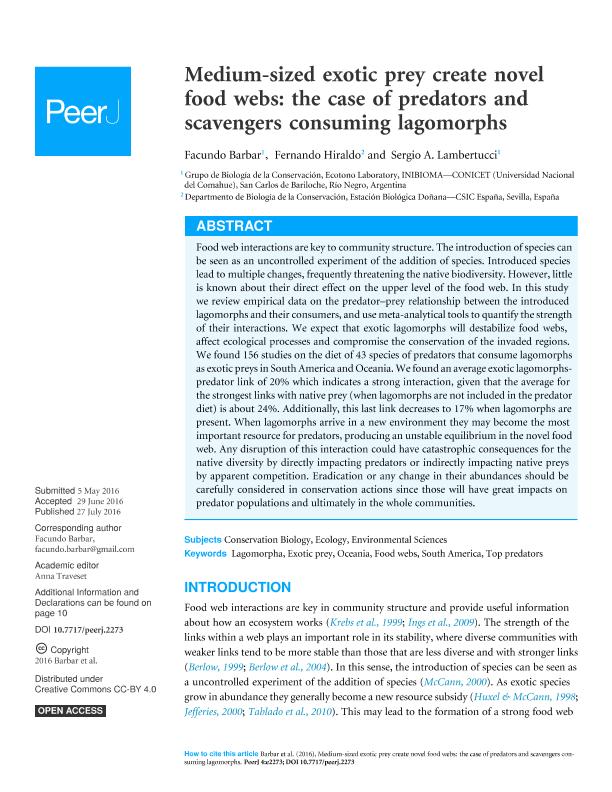Artículo
Medium-sized exotic prey create novel food webs: The case of predators and scavengers consuming lagomorphs
Fecha de publicación:
07/2016
Editorial:
PeerJ Inc.
Revista:
PeerJ
ISSN:
2167-8359
Idioma:
Inglés
Tipo de recurso:
Artículo publicado
Clasificación temática:
Resumen
Food web interactions are key to community structure. The introduction of species can be seen as an uncontrolled experiment of the addition of species. Introduced species lead to multiple changes, frequently threatening the native biodiversity. However, little is known about their direct effect on the upper level of the food web. In this study we review empirical data on the predator-prey relationship between the introduced lagomorphs and their consumers, and use meta-analytical tools to quantify the strength of their interactions. We expect that exotic lagomorphs will destabilize food webs, affect ecological processes and compromise the conservation of the invaded regions. We found 156 studies on the diet of 43 species of predators that consume lagomorphs as exotic preys in South America and Oceania. We found an average exotic lagomorphspredator link of 20% which indicates a strong interaction, given that the average for the strongest links with native prey (when lagomorphs are not included in the predator diet) is about 24%. Additionally, this last link decreases to 17% when lagomorphs are present. When lagomorphs arrive in a new environment they may become the most important resource for predators, producing an unstable equilibrium in the novel food web. Any disruption of this interaction could have catastrophic consequences for the native diversity by directly impacting predators or indirectly impacting native preys by apparent competition. Eradication or any change in their abundances should be carefully considered in conservation actions since those will have great impacts on predator populations and ultimately in the whole communities.
Palabras clave:
EXOTIC PREY
,
FOOD WEBS
,
LAGOMORPHA
,
OCEANIA
,
SOUTH AMERICA
,
TOP PREDATORS
Archivos asociados
Licencia
Identificadores
Colecciones
Articulos(CCT - PATAGONIA NORTE)
Articulos de CTRO.CIENTIFICO TECNOL.CONICET - PATAGONIA NORTE
Articulos de CTRO.CIENTIFICO TECNOL.CONICET - PATAGONIA NORTE
Citación
Barbar, Facundo; Hiraldo, Fernando; Lambertucci, Sergio Agustin; Medium-sized exotic prey create novel food webs: The case of predators and scavengers consuming lagomorphs; PeerJ Inc.; PeerJ; 2016; 7; 7-2016; 1-15
Compartir
Altmétricas




